Previously on Baxter Building: With #125, Fantastic Four permanently lost both of its creators. Yes, almost two years after Jack Kirby jumped ship, Stan Lee also moved on after proving that he really couldn’t bring the series back to its glory days by re-hashing old storylines and ideas. Now, it’s up to a new generation to try and live up to what’s gone before.. by re-hashing old storylines and ideas. We’re doomed, aren’t we?
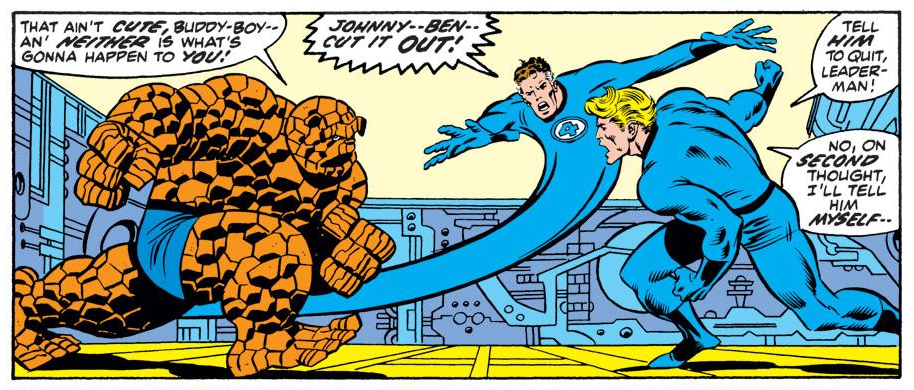
0:00:00-0:8:30: Jeff and I talk about the issues that we’re covering this episode — Fantastic Four #126-133 — and also express more than a little displeasure about the fact that this is actually the second time we’re having to record this episode, thanks to the technical difficulties that ate the first attempt. In fact, consider the non-“Happy Birthday” segment of this clip the unofficial theme song of the episode:
It would help if the issues were really good, but they’re not, and we talk about that as well: the ways in which we’re fully entering the era of “Fantastic Four as cover band,” and also why what would be our natural dismissive tendencies towards that is blunted by our own nostalgia for this stuff, having read it as kids.

0:08:31-0:20:30: Jeff references the Power Records audio version of FF #126 as we delve into the original version of the issue itself, which retells the origin of the team with some slight changes — such as John Buscema drawing the team as their contemporary selves, Roy Thomas retconning references in to comic book history and the insertion of a framing sequence that shows that all of the team have turned into insufferable dicks. Jeff blames Buscema for much of the insufferability, however, whereas I’m just not convinced that Thomas “gets” the interpersonal relationships between the characters. Jeff sings the praises of the professionalism of the issue and Roy Thomas’s “imaginary retcons,” but even he had to admit that the issue is “eugh, oof” to get through. Who says this isn’t the Mighty Marvel Age of Comics Criticism?
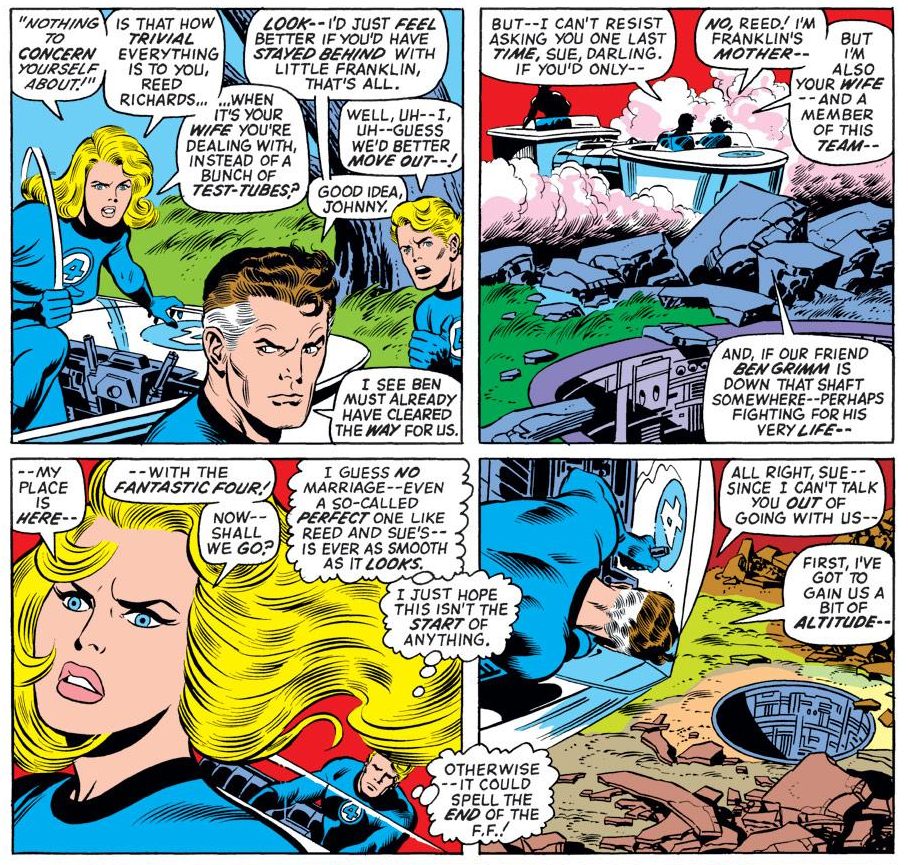
0:20:31-0:33:38: Fantastic Four #127-128 starts with a story named for a euphemism for the butt, which seems only appropriate for our discussion about Roy Thomas’ fragile masculinity. Finally, we get a storyline that deals with the important subject of why female equality might be a good thing in theory if only women weren’t such terrible shrews! On the one hand, we get excited about seeing Sue finally stand up to Reed’s horrific patriarchal attitude, but on the other, we bemoan the fact that it’s being handled by Roy Thomas, a man who seems to dislike the entire idea in the first place. To make matters worse, the plot of the story also demands that the Mole Man is a sap under the thumb of a femme fatale out for herself, because oh God. It’s not all Men’s Right Activism, however; there’s also a random supporting character who gets introduced and vanished in the space of a couple of pages, but Jeff has a theory about that which allows me the chance to do a really shitty pun. All this and a return for one of the lesser-loved elements of the Kirby days! It’s old school comics the way they just don’t make ’em anymore (which, really, might be a good thing, let’s be honest).
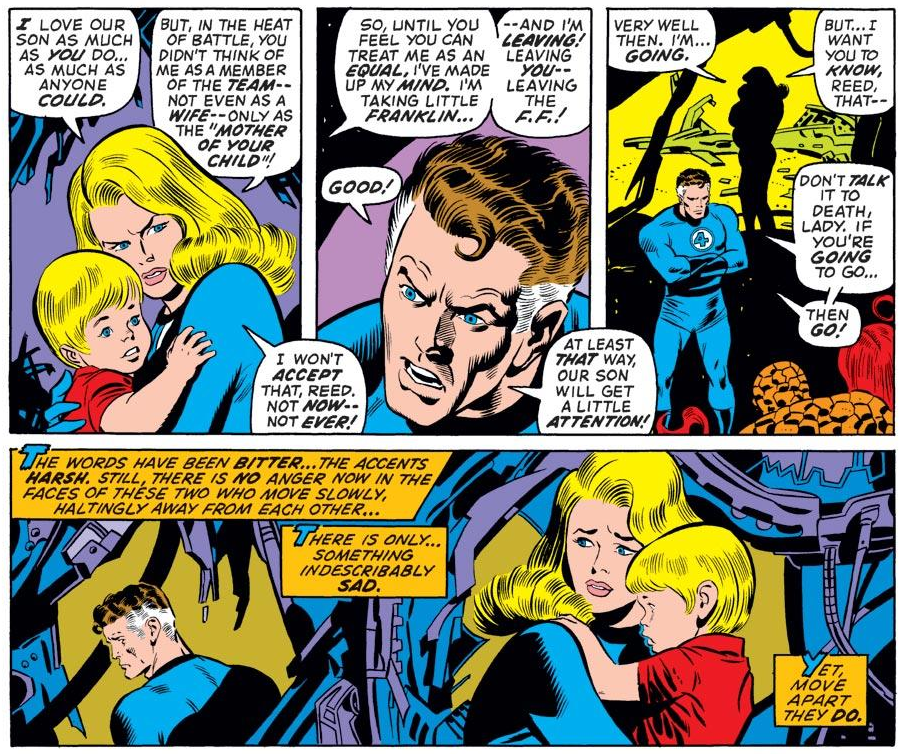
0:33:39-0:55:50: After bringing back the Mole Man, Fantastic Four #129-130 proves that the only way is up by reviving the Frightful Four, with a new hook for the team that appeals to both Jeff and I. (Spoiler: the words “schnooks” and “schlubs” are used to describe them.) It helps that we both dig the new fourth member of the team: Thundra, who once again proves that Roy Thomas is scared of women, even though her reverse chauvinism is actually kind of charming, somehow. But enough about the bad guys — let’s deal with the fact that these two issues manage to get rid of two members of the team. Does Thomas have a plan? Jeff suggests that maybe he does, arguing the case that Thomas is a smart guy, if perhaps a little too smart for the material at times. Meanwhile, I make the case that Thomas is actually a more sensitive writer than he lets on, thanks to the parting scene between Reed and Sue, although he manages to bury that elsewhere in these issues. Plus, John Buscema tries to do Kirby tech and causes a schism between Jeff and myself in the process, and a brief reminder that “Blackagar Boltagon” might be the best name in all of Marvel comics.
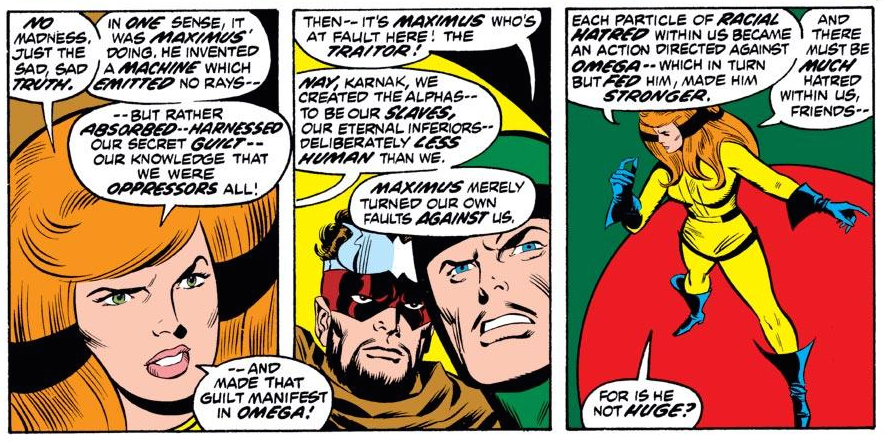
0:55:51-1:12:59: Going out with a bang — yes, these really are the final issues of his initial run — Roy Thomas brings his full-on “I have something important to say” message writing to FF #131-132, and the result is… a really strange couple of issues. Mixed in with the lurid soap operatics of Crystal choosing between Johnny and the newly introduced Quicksilver — giving us our chance to finally have our say about the Johnny/Crystal relationship, and Crystal as a character in general — is Thomas trying to say something important about man’s inhumanity to man (No pun intended), and… well, pretty much failing, thanks to his fondness for pulp tropes and language. Meanwhile, Mister Fantastic fails to change his costume, and Jeff and I disagree about the greater meaning of that, although Jeff’s version of events is probably more interesting than what I think Thomas intended. Let’s just file under “Well, there’ll be another issue along in a second,” shall we…?
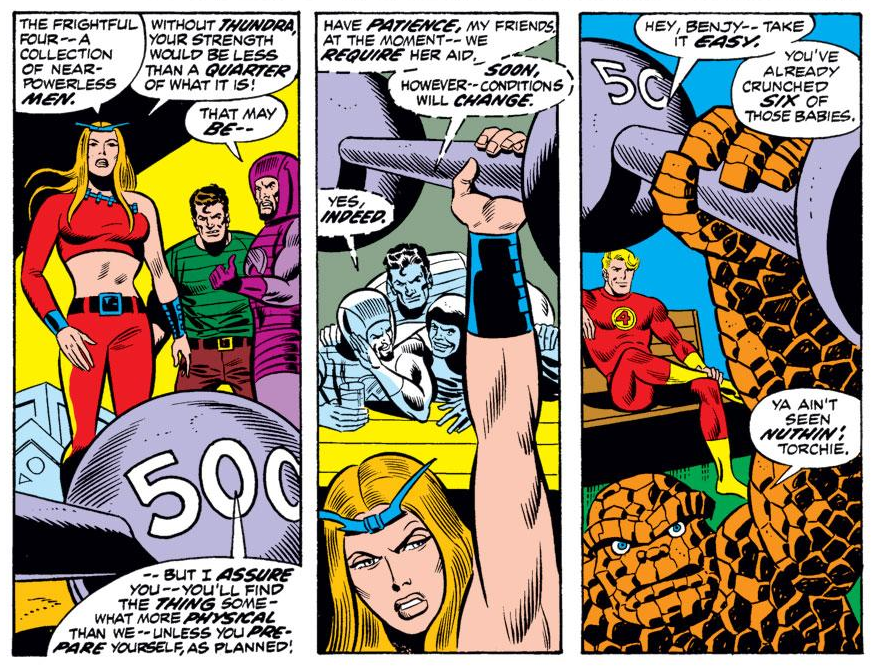
1:13:00-1:23:01: Jeff promises that Fantastic Four #133 has “an amazing change in the creative team,” but he’s not talking about the arrival of Gerry Conway as scripter — he means Ramona Fradon’s guest pencils, which are sadly buried and robbed of their charm by Joe Sinnott’s inks. (For those unfamiliar with Fradon, go here to see what her art normally looks like.) Meanwhile, the story (such as it is) brings Thundra back for a second and offers a fight of the century that not only doesn’t live up to its billing, it also barely takes place in the comic, with the rest of the issue being filler that we barely touched on because, I promise, there’s almost nothing there.
1:23:02-end: “There’s not a lot here,” I say when talking about the speed with which we got through these eight issues, and as we wrap things up — with me once again saying that there’s something authentically FF about these issues because I read them as a kid; I am all that’s wrong with comics — we look ahead to next episode, where we’ll be covering Fantastic Four #134-146, and remind you that you can find us on Twitter, Tumblr and Patreon, as ever. Next week: back to regular Wait, What?-ing, but until then, thank you for putting up with this delayed, brief episode, dear listeners.
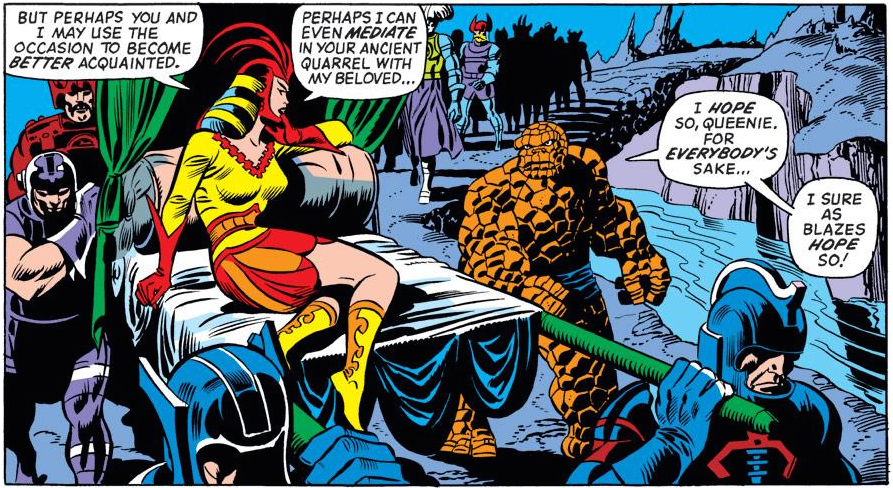


And for those of you who like that cut & paste action:
http://theworkingdraft.com/media/podcasts/BaxterBuildingEp16.mp3
Considering that Jeff is someone who created audio recordings of the Incredible Hulk TV show, I’m entirely unsurprised that he owned the Power Records versions of these issues. : )
That reference is a satisfyingly deep cut, Matthew. Well-played!
I remember these things, but when I originally read them they were mixed in with other books of the time. Binge-reading series from those days now? Some books like Kirby’s Black Panther and Captain America series of the 70s seem to be better-read outside the context of their original publication, when we don’t have them following on immediately after Don McGregor and Steve Englehart, for instance.
From what you describe here, despite them being part of an ongoing storyline, these FF issues may be remembered more fondly by some because they were originally read as just another comic in the stack. I recall the general beats of the stories more than the actual issues — Sue and Reed divorcing, Johnny leaving, etc.
Thomas in those days was coming off of Kree-Skrull War and winding up his Avengers run in general, starting to hand off all of his super-hero books to others, except for Conan. He even won the Shazam award (https://en.wikipedia.org/wiki/Academy_of_Comic_Book_Arts) for best dramatic writer in 1971. But I’m wondering now how his Conan work, as well as being the new editor of the whole Marvel line, affected his handling of super-hero books.
Also: It was quite a shock when artists we thought of as DC-only were showing up in Marvel books. Not only Andru and Fradon in FF, but Mike Sekowsky also did some things — including a brief stint on the Inhumans’ series in Amazing Adventures. Were they given full scripts like what they had at DC or were they thrown into the ‘Marvel Method,’ given just a plot to work with? And what did that method do to their well-practiced story-telling chops? Sekowsky probably wouldn’t have had much problems with just a plot, given his then-fairly-recent runs as both writer and artist at DC . That was the same time Gardner Fox was trying the Marvel Method, as well.
Anyhow, thanks for the memories guys! Looking forward to your next installment…
I was somewhat surprised, given the timeframe of what he was obsessively referencing, that Jim Lee took time to pay homage to the Human Torch costume switch during the HEROES REBORN issues.
Seemed like such a deep cut.
It’s interesting how lifted the re-telling of the origin story is, most of the panel compositions are straight lifts, sometimes Buscema flops a composition, presumably because he’s arranging the panels on the page differently. Also Roy drops Stan’s retcon from FF#11 (I’m assuming it’s Stan as it’s only in a caption) that it’s Ben who saves them in the crash, as opposed to dumb luck.
I sort of love and hate Roy’s tendency to tidy-up the universe, so we get a story where all the underground kingdoms collide. I’m surprised she didn’t ask after Iron Man.
Does the annoying landlord have a key? It certainly appears the FF have one of those leases where the LL can just turn up and harass you at will, which is a very bad lease. It would have been a nice end to that tale if leaning on him was a way supervillains got in, or he was letting them in as away to get rid of the FF.
Reed being unchanging needs to be juxtaposed with him being literally completely malleable. Also as world’s greatest scientist he’s got plenty of imagination, he needs to apply it in ways he’s unused to.
Yeah, Sinnott’s inks on Andre and Fradon didn’t sing. He’s a heavy inker and mostly that’s great when he’s inking artists we don’t like as much as Joe Sinnott. I don’t think he serves Kirby that well for the first few issues when he joins the team as regular inker. I see him learning to ink Kirby so as not to deaden Kirby’s impact and excitement. I reckon 10 issues into a Fradon run things would have looked awesome.
On Ramon Fradon, can I plug that if you are in, or close to London (England), you can see an original page of her Aquaman work in the Comic Creatrix exhibition in the House of Illustration, near Kings Cross station? It’s lovely. You’ve got to the 15th of May. There’s lots of great original art and a reading room. If you can’t get there there’s more than 100 pages of catalogue free on the ipad. No Ramona there, though.